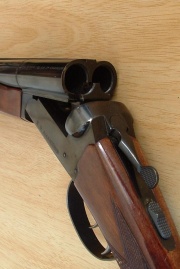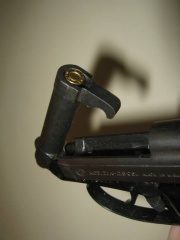Extractor

An extractor is a part in a firearm that holds onto the rim of the ammunition being fired. When the gun's action cycles, the extractor removes the spent casing from the firing chamber. Extractors can be found on bolt action, lever-action, semi-automatic and fully automatic firearms. Break-action shotguns, such as those with single or double barrels, typically have an extractor that operates when the action is broken open. Extractors are also found on revolvers, removing cases either singly (as in a fixed-cylinder single action revolver) or all at once (as in a double action revolver with a swing-out or top-break cylinder). For rimless cases, an extractor groove in the ammunition may serve as the point from which the extractor works. For rimmed cases, the rim of the cartridge most commonly serves as the point from which the extractor works. Not all firearms have extractors.
In bolt action, lever-action, pump action, and semi- or fully-automatic firearms, extractors typically work in conjunction with ejectors to remove a fired, empty cartridge from the chamber. The extractor removes the cartridge case from the chamber, essentially pulling the case to the rear. At some point in the rearward travel the case makes contact with the ejector which actually "kicks" the expended case out of the firearm making room for an unfired cartridge to be loaded.
Some firearms have no ejectors, only extractors, requiring the user to manually remove spent cartridges. In this situation the extractor pulls the case out of the chamber far enough to give the user a good grip on the cartridge, but not far enough to remove the entire cartridge from the chamber. This situation is encountered on some single shot rifles and on some single and double-barreled shotguns.
Some very early blowback pistols used ammunition with no rim or extractor groove on the cartridge cases (e.g., 5mm Bergmann), and such pistols therefore lacked extractors. The spent case was forced out of the chamber by recoil, and was subsequently ejected. As this system did not provide for easy clearance of misfires, it was not very successful, especially for self-defense handguns needing to be cleared quickly and reloaded in the event of a cartridge primer malfunction. Nonetheless, there are examples of contemporary modern semi-automatic pistols that do not have extractors even to this day, such as the Beretta Bobcat, Beretta Model 21A, and clones of the Beretta designs such as the Taurus PT22 that are successful. These modern pistols typically have flip-up barrels, to permit easy loading without necessarily cycling a slide against a strong recoil spring, making these pistols suitable for use by the elderly and others with less hand strength. The trade made is that in the event of a cartridge primer malfunction, the gun is rendered useless until the action can be cycled by someone with full hand strength. Still, for someone without the hand strength to handle a semi-automatic firearm with a slide against a strong recoil spring, the trade is often made.
An extractor also performs the function of an ejector in revolvers. When the striking force applied to the ejector rod is hard and fast enough, the extractor will typically eject the empty case(s) from the cylinder. Some break-action shotguns are also designed to eject empty shells completely out of the chamber when the barrel is opened.
Extractors or cartridge pullers can be tools to pull out bullet shells, used as a small gudget with three claws that come on a ring or mounted on some rod that serves as handle, The extractors can be of different gauges from 8" bore to 22" bore. These extractors that are not built as part of the shotgun are found with combined with a dog whistle or sometimes part of a multi tool. (Some examples can be found here.)

This article or section is just a stub, and could use more information to fill in the missing bits.
You (yes, you!) can help Gunsopedia and our users by using your own knowledge to expand it
